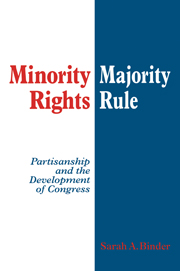Book contents
- Frontmatter
- Contents
- List of tables and figures
- Preface
- 1 The partisan basis of procedural choice
- 2 The evolving concepts of House and Senate minority rights
- 3 Procedural choice in the early Congress: The case of the “previous question”
- 4 Allocating minority rights in the House, 1789–1990
- 5 Institutionalizing party in the nineteenth-century House
- 6 Stacking the partisan deck in the twentieth-century House
- 7 Inherited rules and procedural choice in the Senate
- 8 Assessing the partisan theory
- Appendix 1 Summary of changes in minority rights
- Appendix 2 Measuring congressional workload
- Appendix 3 Measuring party behavior
- Bibliography
- Index
5 - Institutionalizing party in the nineteenth-century House
Published online by Cambridge University Press: 10 December 2009
- Frontmatter
- Contents
- List of tables and figures
- Preface
- 1 The partisan basis of procedural choice
- 2 The evolving concepts of House and Senate minority rights
- 3 Procedural choice in the early Congress: The case of the “previous question”
- 4 Allocating minority rights in the House, 1789–1990
- 5 Institutionalizing party in the nineteenth-century House
- 6 Stacking the partisan deck in the twentieth-century House
- 7 Inherited rules and procedural choice in the Senate
- 8 Assessing the partisan theory
- Appendix 1 Summary of changes in minority rights
- Appendix 2 Measuring congressional workload
- Appendix 3 Measuring party behavior
- Bibliography
- Index
Summary
Lessons drawn from the politics of the previous question rule in Chapter 3 and the statistical evidence in Chapter 4 suggest a striking partisan dynamic to changes in House minority rights. Short-term concerns about partisan advantage – rather than broader concerns about institutional well-being – appear to motivate changes in the distribution of parliamentary rights in the House over time. If such a conclusion accurately captures the politics of minority rights, certain patterns should emerge from a more detailed, qualitative assessment of individual cases of rights creation and suppression after adoption of the previous question rule in 1812. First, rules changes restricting minority rights should elicit strong partisan divisions, with majority party members voting largely in favor and minority party members largely opposed. Second, rules changes extending minority rights should be contingent on a cross-party coalition composed primarily of minority party members and a few majority party defectors. Third, there should be evidence of a policy-related purpose to such rules changes. Parties seeking to suppress rights should have a collective goal of legislative victories sufficiently important to them to motivate manipulation of chamber rules in face of minority obstructionism. Similarly, cross-party coalitions seeking to reinforce rights should have enough legislative concerns in common to warrant collaboration across party lines to secure a favorable change in House rules.
In this and the next chapter, I show how individual cases of creation and suppression across the nineteenth and twentieth centuries fit the general pattern of change in minority rights characterized in Chapter 4.
- Type
- Chapter
- Information
- Minority Rights, Majority RulePartisanship and the Development of Congress, pp. 86 - 131Publisher: Cambridge University PressPrint publication year: 1997



